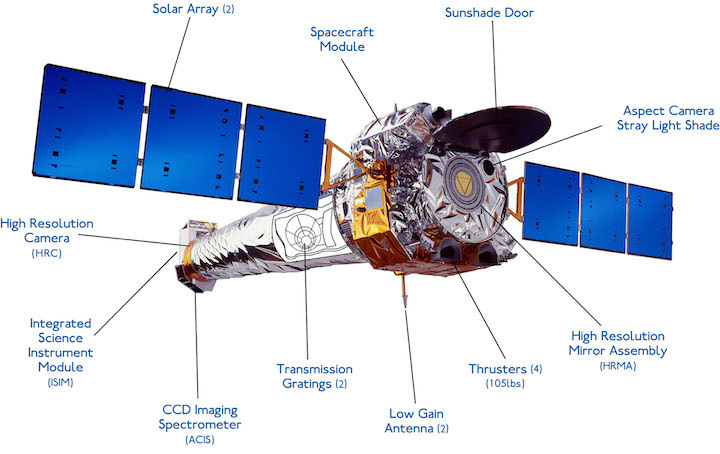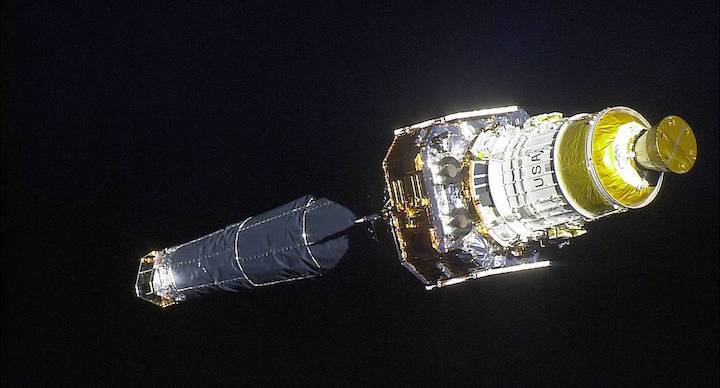26.09.2018

NASA has awarded a contract extension to the Smithsonian Astrophysical Observatory (SAO) in Cambridge, Massachusetts, to continue operations and science support for the agency's Chandra X-ray Observatory.
The contract extends the agreement between NASA and SAO through Sept. 30, 2024, followed by two three-year options that would extend the contract through Sept. 30, 2030. The total potential value of the contract extension is $563.5 million.
This contract covers continued operation of the Chandra X-ray Center (CXC) in Cambridge, which conducts key aspects of Chandra's observation, operations and research program. Core functions of the CXC include system engineering, ground system development and maintenance, mission operations, science and operations planning, science research and dissemination, and outreach support.
Since its launch on July 23, 1999, Chandra has been NASA's flagship mission for X-ray astronomy and is among NASA's fleet of Great Observatories. The agency’s Marshall Space Flight Center in Huntsville, Alabama, manages the Chandra program for the agency's Science Mission Directorate in Washington.
Quelle: NASA
+++
Chandra Spacecraft and Instruments
The Chandra telescope system consists of four pairs of mirrors and their support structure. X-ray telescopes must be very different from optical telescopes. Because of their high-energy, X-ray photons penetrate into a mirror much as bullets slam into a wall.
Imagine making the surface of the Earth so smooth that the highest mountain was less than two meters (78 inches) tall! On a much smaller scale, the scientists and engineers at Raytheon Optical Systems in Danbury, Connecticut accomplished an equivalent feat when they polished and ground the four pairs of Chandra mirrors to the smoothness of a few atoms.
Just as bullets ricochet when they hit a wall at a grazing angle, so too will X-rays ricochet off mirrors. The mirrors have to be exquisitely shaped and aligned nearly parallel to incoming X-rays. Thus they look more like glass barrels than the familiar dish shape of optical telescopes.
Science Instruments
The Chandra X-Ray Observatory combines the mirrors with four science instruments to capture and probe the X-rays from astronomical sources. The incoming X-rays are focused by the mirrors to a tiny spot (about half as wide as a human hair) on the focal plane, about 30 feet away. The focal plane science instruments, ACIS and HRC, are well matched to capture the sharp images formed by the mirrors and to provide information about the incoming X-rays: their number, position, energy and time of arrival.
Two additional science instruments provide detailed information about the X-ray energy, the LETG and HETG spectrometers. These are grating arrays which can be flipped into the path of the X-rays just behind the mirrors, where they redirect ( diffract ) the X-rays according to their energy. The X-ray position is measured by HRC or ACIS , so that the exact energy can be determined. The science instruments have complementary capabilities to record and analyze X-ray images of celestial objects and probe their physical conditions with unprecedented accuracy.
Spacecraft
The spacecraft system provides the support structure and environment necessary for the telescope and the science instruments to work as an observatory. In order to provide motion to the observatory, Chandra has two different sets of thrusters: one for propulsion and the other for momentum unloading.
The propulsion thrusters were used immediately after launch to help propel Chandra into its final orbit, which is elliptical and very high in altitude. The momentum unloading thrusters are periodically used to apply torques to Chandra and, thereby, lower the accumulated momentum in its reaction wheels, which are used to control Chandra's attitude.
Quelle: NASA
+++

1999, the space shuttle Columbia, mission STS-93, launched from NASA’s Kennedy Space Center on a four-day mission to deliver the Chandra X-ray Observatory to low-Earth orbit. Chandra was then propelled to an orbit of 44,759 miles in altitude using a two-stage Inertial Upper Stage. This was the first mission in shuttle history to be commanded by a woman, astronaut Eileen Collins. Here, Chandra and its upper stage separate from Columbia with the STS-93 HDTV Camcorder stowed inside the crew cabin. NASA's Marshall Space Flight Center manages the Chandra program for NASA's Science Mission Directorate. The NASA History Program is responsible for generating, disseminating, and preserving NASA’s remarkable history and providing a comprehensive understanding of the institutional, cultural, social, political, economic, technological and scientific aspects of NASA’s activities in aeronautics and space.
Quelle: NASA

